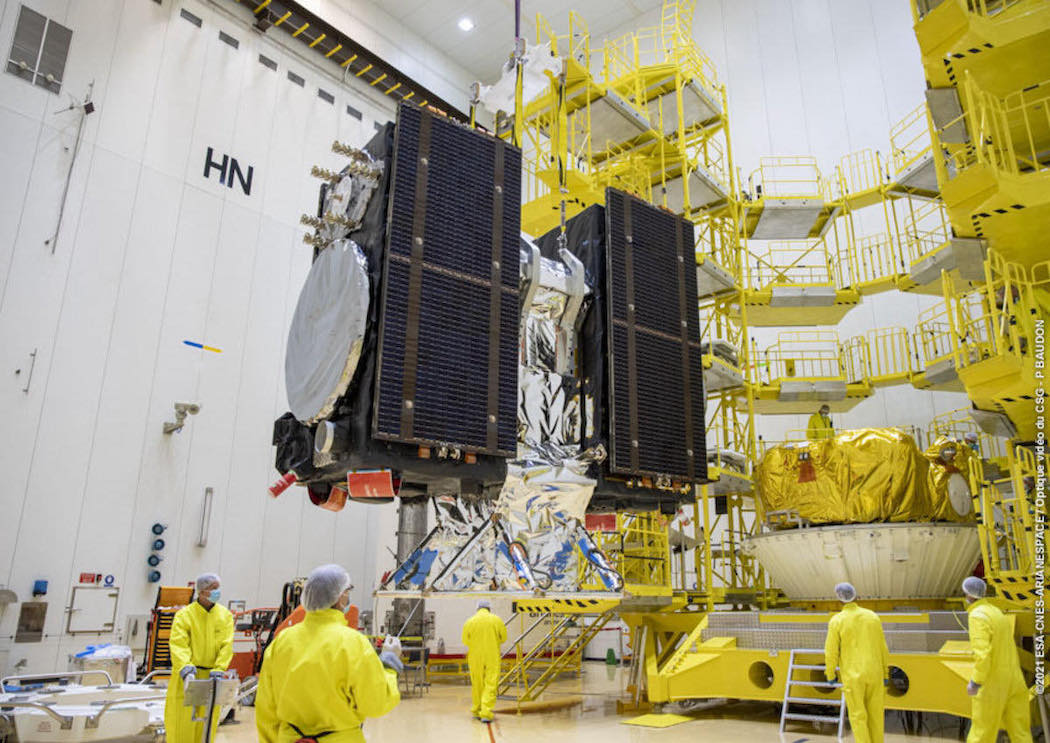
Two more Galileo navigation satellites are set for liftoff Thursday night from French Guiana on a Soyuz rocket, the first mission in more than three years to add to Europe’s space-based positioning and timing network.
The two Galileo satellites, each weighing about 1,576 pounds (715 kilograms) fully fueled, are mounted side-by-side inside the payload fairing of their Soyuz launcher.
Designed for 12-year missions, the new spacecraft will join 26 Galileo satellites already in orbit providing navigation services around the world for the European Union’s mulbillion-euro flagship space program. Ten launches of Soyuz and Ariane 5 rockets from French Guiana since October 2011 have deployed the operational Galileo satellites, which are spread out in three orbital planes around 14,400 miles (23,200 kilometers) above Earth.
The full constellation needs 30 satellites, including 24 active platforms and six spares.
“The purpose of the coming up launch of Galileo is to complete the deployments of the satellites and the population of the different orbital planes to ensure that the constellation is complete,” said Andrea Cotellessa, head of the Galileo space segment management office at the European Space Agency. “Our constellation requires eight operational satellites and two spare satellites per plane, and this has not been achieved yet.”
The next two Galileo satellites will head into space on top of a Soyuz ST-B rocket. Liftoff from the Guiana Space Center, Europe’s spaceport on the northeastern coast of South America, is timed for exactly 7:27:25 p.m. EST Thursday (0027:25 GMT Friday), according to a spokesperson from Arianespace, the launch service provider.
Launch is set for 9:27 p.m. local time in French Guiana, a French overseas territory sandwiched between Suriname and Brazil.
The Soyuz launcher will head northeast from the Guiana Space Center over the Atlantic Ocean, lining up for a trajectory into an orbit inclined 57.1 degrees to the equator.
The rocket will shed its four first stage boosters, core stage, and payload fairing in the first five minutes of the mission. A third stage engine will place a Fregat upper stage and the two Galileo satellites on a suborbital trajectory around nine minutes after liftoff.
An initial burn with the Fregat upper stage will first place the Galileo satellites into an elliptical transfer orbit. Another engine firing 3 hours, 42 minutes, into the mission will aim to position the satellites into a near-circular orbit around 14,615 miles (23,522 kilometers) above Earth.
The satellites will deploy from the Fregat upper stage at 11:19 p.m. EST (0419 GMT).

Once the satellites separate from the Fregat upper stage, ground teams at a Galileo control center in Oberpfaffenhofen, Germany, will take command of the spacecraft. The satellites will unfurl their solar panels and begin a customary series of post-launch tests before entering operational service.
Galileo satellites are already beaming navigation signals to users around the world. More than 2 billion smartphones have been sold with Galileo-enabled chipsets, allowing users to locate themselves with navigation signals from Galileo satellites alongside data from the U.S. military’s Global Positioning System network.
The launch Thursday night will be the final mission from the spaceport in French Guiana before liftoff Dec. 22 of the James Webb Space Telescope, a $9.7 billion observatory developed by NASA, ESA, and the Canadian Space Agency.
Webb, the most expensive space science mission in history, will blast off on top of a heavy-lift Ariane 5 rocket. Officials at the Guiana Space Center require about two weeks to reconfigure ground infrastructure between launches, meaning the Soyuz flight needs to get off the ground by around Dec. 8 to ensure the Webb launch remains on schedule.
The Soyuz launch with the next two Galileo satellites was previously planned for Wednesday night, but officials delayed the flight a day due to a poor weather forecast.
The mission will mark the 26th flight of a Russian Soyuz rocket from French Guiana since 2011.
The two Galileo spacecraft launching Thursday night were built by OHB in Bremen, Germany. The L-band navigation payloads on each satellite was supplied by SSTL in the United Kingdom.
The satellites are the first two of 12 Galileo spacecraft ordered in a third batch contract from ESA in 2017. The “Batch 3” satellites, with the same capabilities as the previous 26, will sustain the Galileo constellation until a new generation of spacecraft is ready for launch.
Over the next few years, three Soyuz launches and three flights of Europe’s new Ariane 6 will rocket will each carry two Galileo satellites into orbit.
The second-generation satellites should begin launching by the end of 2024, according to ESA, which manages spacecraft development for the Galileo system on behalf of the European Commission, the EU’s executive body.
“They will be more powerful,” said Paul Verhoef, ESA’s director of navigation. “They will be, as a result, also heavier, but they will have more capabilities. In particular, they will be fully flexible, fully digital, so we can re-program them in orbit.
“At the moment with the first generation, if we want to provide significant new services, we’re going to have to bring completely new satellites into orbit,” Verhoef said. “With the second generation, we have decided to do it differently and allow this capability, de facto, to be on the satellites, so we can change things as markets demand it in a relatively quick way.”
Earlier this year, the European Commission and ESA awarded contracts to Airbus and Thales Alenia Space for 12 second-generation, or G2, Galileo satellites. Each company won a deal for six spacecraft, which will carry navigation payloads built on the European continent, rather than by SSTL in the UK.
SSTL was excluded from the new generation of Galileo satellites after Brexit. European officials required sensitive elements of the Galileo program to come from EU member states.
Email the author.
Follow Stephen Clark on Twitter: @StephenClark1.
from Spaceflight Now https://ift.tt/3lwwLWi
via World Space Info







0 comments:
Post a Comment